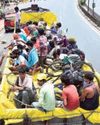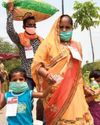
THE UNION GOVERNMENT HAS BEEN TAKING pride in its supposedly graded, pre-emptive and proactive approach in tackling the COVID-19 crisis. Yet a close look at the way the authorities have gone about the task gives the lie to these claims. India’s case fatality rate (CFR) has been very low and it has been possible to slow down the rate of “doubling” of new cases. Yet, this does not really show the real picture. The comparison with European countries such as Italy or Spain that have had an abnormally high spread of the infection and case fatalities owing to demographic factors makes little sense. Any comparison should ideally have been made with countries with similar populations and demographic indicators like age and stages of development. In fact, fatalities have been low in much of the developing world—in Africa, South and South East Asia, and also Eastern Europe.
Unlike in many other countries where the epidemic is ebbing, it is still on the rise in India and has, in fact, spread significantly in May. Testing capacities have been stepped up to around 95,000 a day. Yet, according to data available on the website of Worldometers, a global COVID-19 online tracker, India ranks 14th among countries with the highest number of cases but its testing per million population is much lower than that of countries with fewer confirmed cases such as Vietnam, Taiwan, and Thailand.
LOCKDOWN IMPACT
The government now belatedly realises the consequences of a blanket lockdown for people with non-COVID morbidities such as diabetes, haemophilia, cancer, and for patients requiring critical care such as dialysis and blood transfusion. The consequences of the suspension of immunisation services and hurdles created in the check-up of pregnant women requiring antenatal care are also sinking in.
Diese Geschichte stammt aus der May 22, 2020-Ausgabe von FRONTLINE.
Starten Sie Ihre 7-tägige kostenlose Testversion von Magzter GOLD, um auf Tausende kuratierte Premium-Storys sowie über 8.000 Zeitschriften und Zeitungen zuzugreifen.
Bereits Abonnent ? Anmelden
Diese Geschichte stammt aus der May 22, 2020-Ausgabe von FRONTLINE.
Starten Sie Ihre 7-tägige kostenlose Testversion von Magzter GOLD, um auf Tausende kuratierte Premium-Storys sowie über 8.000 Zeitschriften und Zeitungen zuzugreifen.
Bereits Abonnent? Anmelden

How Not To Handle An Epidemic
The lockdowns were meant to buy time to put in place appropriate health measures and contain the coronavirus’ spread, but they have failed to achieve the objective and heaped immense misery on the marginalised sections of society. India is still in the exponential phase of the COVID-19 infection and community transmission is a reality that the government refuses to accept.

Tragedy on foot
As the COVID-19-induced lockdown cuts the ground beneath their feet in Tamil Nadu, thousands of migrant workers are trudging along the highway to the relative safety of their upcountry homes.

Sarpanchs as game changers
Odisha manages to keep COVID-19 well under control because of the strong participation of panchayati raj institutions and the community at the grass-roots level under the leadership of Chief Minister Naveen Patnaik.

Scapegoating China
As the COVID-19 death rate spikes and the economy tanks in the United States, Donald Trump and his advisers target China and the World Health Organisation with an eye to winning the forthcoming presidential election.

New worries
Kerala’s measured approach to the pandemic and lockdown has yielded results. But it still has to grapple with their huge economic impact on its economy, which it feels the Centre’s special financial relief package does little to alleviate.
No love lost for labour
Taking advantage of the lockdown and the inability of workers to organise protests, many State governments introduce sweeping changes to labour laws to the detriment of workers on the pretext of reviving production and boosting the economy.

Capital's Malthusian moment
In a world that needs substantial reorienting of production and distribution, Indian capital is resorting to a militant form of moribund neoliberalism to overcome its current crisis. In this pursuit of profit, it is ready and willing to throw into mortal peril millions whom it adjudicates as not worth their means—an admixture of social Darwinism born of capital’s avarice and brutalism spawned by Hindutva. .

Understanding migration
When governments and their plans are found to be blatantly wanting in addressing reverse migration, exercises such as the Ekta Parishad’s survey of migrant workers throughout India can be useful to work out creative long-lasting solutions.

Waiting for Jabalpur moment
The Supreme Court’s role in ensuring executive accountability during the ongoing lockdown leaves much to be desired. Standing in shining contrast is the record of some High Courts.

An empty package
The Modi regime, which has been unable to control the COVID-19 infection, restore economic activity and provide relief to millions exposed to starvation, trains its sights on Indian democracy, making use of the panic generated by fear and a lockdown that forecloses paths of resistance.